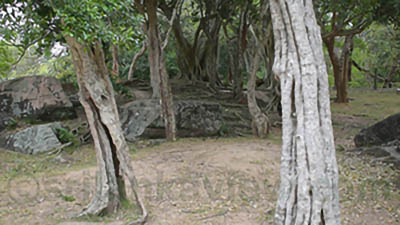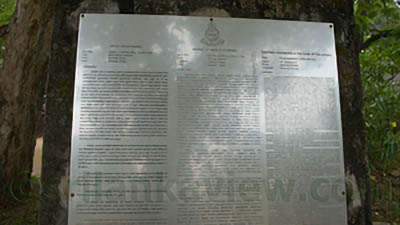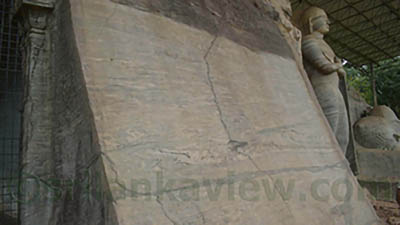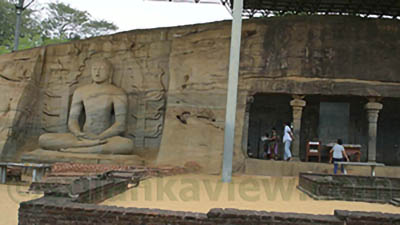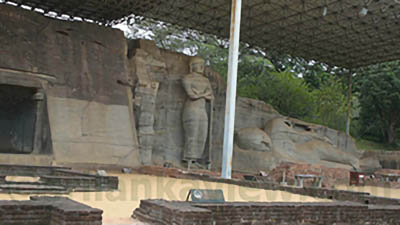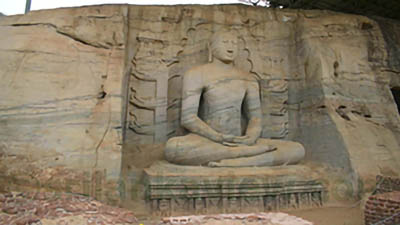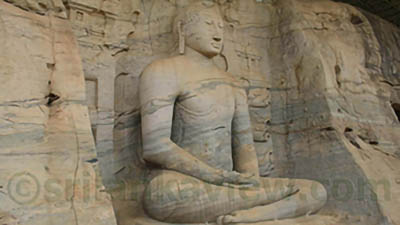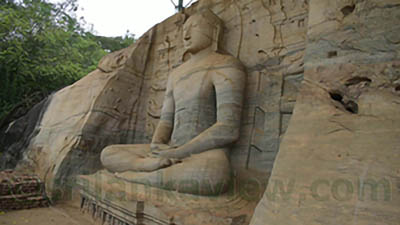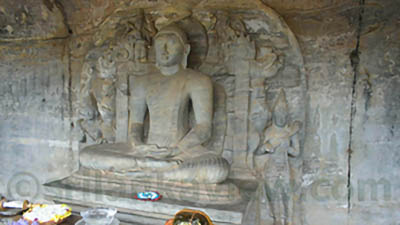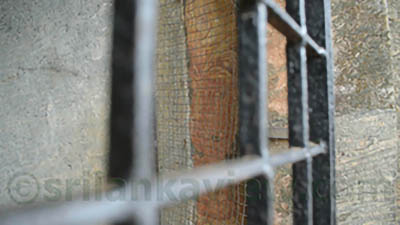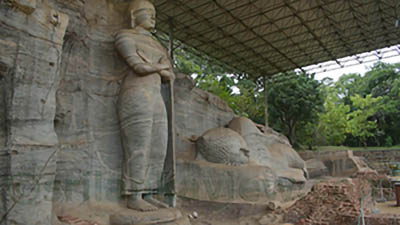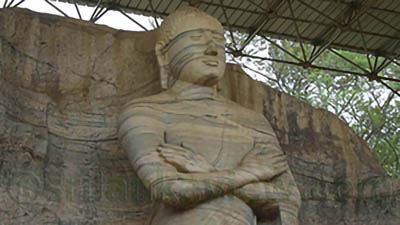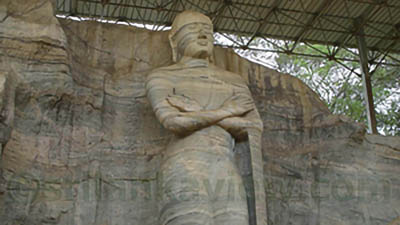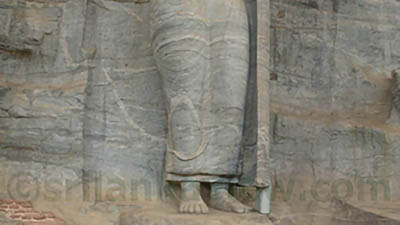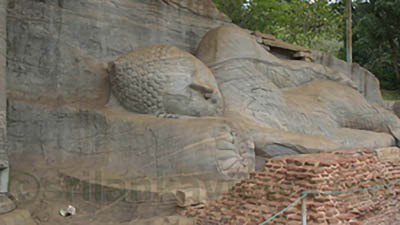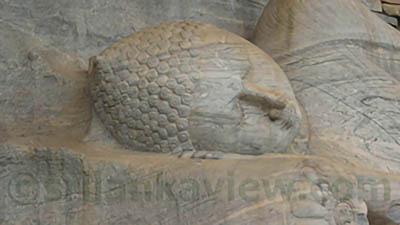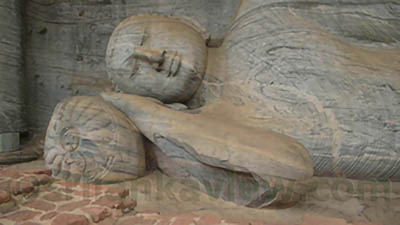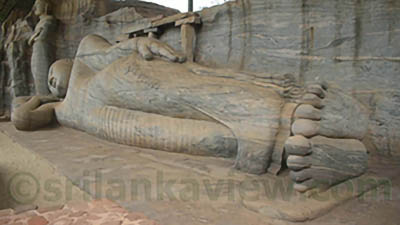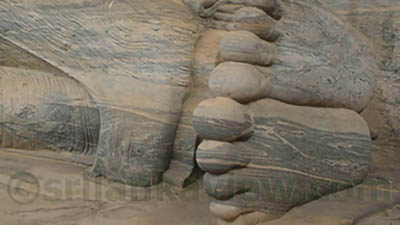Gal Vihara
Use Google Translator at Navigation Bar to read in Sinhala or Tamil or in any other Language
Gal Viharaya, Polonnaruwa - History, Buddha Statues,Details
Gal Viharaya History and Details
Gal Viharaya is a significant site located within the ancient city of Polonnaruwa in Sri Lanka. It is renowned for its remarkable rock-cut Buddhist sculptures, showcasing the exquisite craftsmanship of the Polonnaruwa period.
Location of Gal Vihara is in the northern part of Polonnaruwa, about 200 meters North of Kiri Vehera (Alahana Pirivena) . It is situated within a tranquil park-like setting, surrounded by trees and vegetation, creating a serene atmosphere for visitors.
Gal Vihara was built by King Parakramabahu I (1153-1186 CE), a celebrated ruler of the Polonnaruwa Kingdom.
The Gal Vihara is famous for its four main sculptures, all carved out of a single granite rock face. The details of Gal Vihara sculptures with dimensions can be narrated as
Standing Buddha Statue: The largest and most iconic of the four, this statue stands at approximately 7 meters (22 feet 9 inch) in height. It depicts the Buddha in a dignified posture, with a serene expression and hands held in a gesture of "Abhaya Mudra" indicating the "Gesture of Reassurance" or "Gesture of Fearlessness."
Seated Buddha Statue: Located adjacent to the standing statue, this sculpture portrays the Buddha in a meditative posture, known as the "Dhyana Mudra." The Dhyana Mudra represents the state of deep contemplation and inner tranquility. It symbolizes the union of wisdom and concentration, leading to spiritual realization and enlightenment.The height of this Buddha Statue is about 4.6 meters (15 feet 2 inch). This seated Buddha statue is considered to be the most acclaimed artistic sculpture in Sri Lanka, reflecting its exceptional craftsmanship and cultural significance.
Reclining Buddha Statue: Positioned a little distance away from the standing and seated statues, this sculpture represents the Buddha in a reclining position, resting on his right elbow. It is a vivid depiction of the Buddha's passing into Nirvana (Parinirvana). This statue is approximately 14 meters (46 feet 4 inch) in length.
Seated Buddha Statue inside the cave: This smaller statue is positioned in a cave within Gal Vihara, showcasing the Buddha seated with crossed legs in a meditative pose.
The sculptures at Gal Vihara exhibit the characteristic features of the Sinhalese Buddhist architectural style prevalent during the Polonnaruwa period. They showcase a harmonious blend of Indian and local artistic influences, reflecting the cultural exchange and artistic achievements of the time.
Gal Vihara holds immense religious importance for Buddhists and serves as a place of worship and reverence. It is considered a sacred site, where devotees and visitors pay homage to the Buddha and find spiritual solace.
Efforts have been made to preserve and protect Gal Vihara over the years. The site is now under the care of the Sri Lanka Department of Archaeology, which has implemented measures to safeguard the sculptures from erosion and damage caused by weathering and human activity.
Visitors to Gal Vihara can witness the awe-inspiring beauty of the rock-cut sculptures up close. The site provides a serene and contemplative environment for exploration and photography, allowing individuals to appreciate the skill and artistry of the ancient craftsmen.
You can access over 20 photographs of 1920 x 1080 px size Gal Vihara images here.
 copy.jpg)
Seated Buddha Statue
 copy.jpg)
Buddha Statue in cave
Ancient Polonnaruwa Kingdom
Gal Vihara Information
The sculptures of Gal Vihara are renowned for their exceptional artistic details and precision. The craftsmen skillfully carved intricate features such as the facial expressions, robes, and hair of the Buddha statues. The flowing robes exhibit delicate folds, and the facial expressions convey a sense of serenity and compassion.
Gal Vihara has had a significant influence on the development of Buddhist art in Sri Lanka and neighboring regions. The standing Buddha statue, in particular, is considered an iconic representation of the Buddha in Sri Lankan art. Its proportions, posture, and facial features have become a model for subsequent Buddha statues in Sri Lanka and other Buddhist cultures.
The sculptures of Gal Vihara hold deep symbolic and spiritual significance. They represent important moments in the life of the Buddha and convey teachings and ideals of Buddhism. The standing statue represents the Buddha's role as a teacher and protector, while the seated statue represents his pursuit of enlightenment. The reclining statue symbolizes the Buddha's ultimate attainment of Nirvana and the transcendence of suffering.
Over the centuries, Gal Vihara has faced various challenges that have affected the preservation of the sculptures. Environmental factors such as weathering, erosion, and moss growth have posed threats to the delicate rock surface. Additionally, human activities, such as touching or climbing on the sculptures, can cause damage. Conservation efforts and restrictions on visitor access have been implemented to protect the site.
Gal Vihara's location within the ancient city of Polonnaruwa adds to its historical and cultural importance. The proximity to other prominent structures such as the Royal Palace and other temples highlights the central role that Buddhism played in the Polonnaruwa Kingdom. The site's serene setting, surrounded by nature, enhances the spiritual ambiance and allows visitors to connect with the tranquility of the Buddhist teachings.
Gal Vihara is recognized as part of the UNESCO World Heritage Site of "Sacred City of Polonnaruwa." The site, including Gal Vihara, is acknowledged for its outstanding universal value and cultural significance, representing a significant period in Sri Lanka's history.
Buddha Statue of Gal Vihara
 copy.jpg)
Art and Architecture of Gal Vihara
Gal Vihara stands as a testament to the skill, devotion, and artistic mastery of the ancient craftsmen who painstakingly created these masterpieces. Each monument within the Gal Vihara complex has its own unique story to tell. The Gal Viharaya, with its serene beauty, invites contemplation and introspection. The tranquil expressions on the faces of the Buddha statues inspire a sense of calm and inner peace.
.
.
 copy.jpg)
Gal Viharaya Terrace View
.
.



 copy.jpg)
